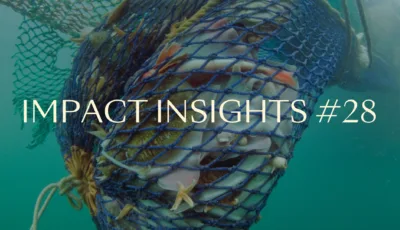Impact Insights #14

Discover the latest impact insights curated by Norselab's Impact Analyst, Oda Standal.
■ SEC faces legal challenges over climate disclosure mandates for public companies
On the 2nd of March, the U.S. Securities and Exchange Commission (SEC) established the release and adoption of climate requirements for public companies in the U.S. Only a few weeks after implementation, it was paused due to a series of legal challenges by several states and business groups.
The original draft mandates that public companies provide disclosure on climate risks facing their businesses, as well as the financial impact of severe weather events, plans to address those risks, and, in some cases, greenhouse gas emissions from operations. Arguments against the rules claim that the requirements are too burdensome and expensive and that the information requested is speculative and unreliable.
The SEC said in a statement that despite the decision to pause, it will "continue vigorously defending" the new climate requirements, which it described as "consistent with applicable law and within the commission's long-standing authority.”
■ Women face significantly greater financial losses compared to men due to climate-related events
The Unjust Climate report by the FAO underscores the disproportionate impact of climate change on women, particularly in rural areas and the agricultural sector. Female heads of households in rural regions of low and middle-income countries (LMICs) face significantly greater financial losses compared to men due to climate-related events.
Research reveals that, on average, these women lose 8 percent more of their income due to heat stress and 3 percent more due to floods than their male counterparts. Furthermore, with every 1°C rise in temperatures, women experience a staggering 34% greater loss in total income compared to men. This disparity is exacerbated by existing gender inequalities in agricultural productivity and wages. Structural barriers such as limited access to resources, services, and employment opportunities further impede women's ability to adapt to climate change impacts.
Discriminatory norms and policies disproportionately burden women with care and domestic responsibilities, restrict their land rights, and impede their decision-making autonomy. Only a small fraction of climate actions proposed in national climate plans mention women, highlighting the urgent need for gender-responsive policies and interventions to mitigate the gender disparities exacerbated by climate change.
■ UNESCO estimates that one in six cultural heritage sites is threatened by climate change
The Knowe of Swandro, situated off the coast of Scotland, is a significant archeological site harboring remnants of both the Iron Age and Norse settlements. The site is under imminent threat from coastal erosion exacerbated by climate change. Hundreds of archeological sites face similar threats.
In northern England, the waterlogged soil that preserved Roman tablets for millennia is drying out. In Iraq, an ancient city is being buried under tonnes of sand, and in the Arctic, indigenous artifacts are being destroyed as the permafrost thaws. Despite archaeologists’ efforts to preserve the sites, the lack of funding poses major obstacles. Moving sites and other mitigation efforts, such as building protective armor, is costly, and on the climate change to-do list, archeological preservation is not considered a top priority. The coming years will leave researchers to grapple with the difficult decision of deciding which sites to prioritize for conservation and which can be left to decay.
■ France passes bill to curb fast fashion waste and penalize ultra-fast fashion retailers
Last week, French lawmakers made a significant move by unanimously passing a bill aimed at curbing the negative impacts of fast fashion. The legislation proposes increased penalties on fast fashion products, eventually reaching €10 per item by 2030, and also seeks to ban fast fashion advertising.
The legislative move is a response to the alarming overconsumption fueled by fast fashion retailers, where the use of trend-driven clothing encourages consumers to purchase and discard garments at a high rate. As a result, vast quantities of textiles end up in landfills, worsening the environmental crisis. The fast fashion industry's emphasis on profit maximization often comes at the expense of human rights and environmental sustainability, with production processes needing vast amounts of resources, as well as generating substantial waste and pollution.
France already has repair schemes in place to incentivize individuals to mend clothes and shoes rather than dispose of them, promoting a culture of reuse and sustainability. Fast fashion brands such as Shein and Timu are under further scrutiny for their use of AI in marketing and product development. In a lawsuit between Shein and three independent designers, it was alleged that the brand’s AI technology intentionally pirates their designs and misleads consumers with false product popularity and quality information. Such practices not only erode consumer trust but also disrupt fair competition within the industry.
■ Fog harvesting can help solve water scarcity issues
As concerns about water scarcity mount globally, engineers are turning to innovative methods to tap into alternative water sources, including harnessing moisture from the air. One method, inspired by ancient techniques used by civilizations such as the Inca, involves collecting dew and fog. Traditional practices involved placing buckets under trees to catch condensation, while modern approaches use polymer mesh traps to capture small water droplets from fog. These droplets accumulate and flow into reservoirs, providing a sustainable water source, especially in foggy areas. Recent advancements have significantly increased water yield from fog harvesting.
In regions with low fog occurrence, engineers utilize radiative cooling techniques to condense water from the air. Radiative cooling involves using materials that absorb heat during the day and release it at night, creating temperature differences that facilitate the condensation of water from the air. This method requires power, typically from nearby turbines or solar panels, which can be expensive. In places with very low humidity, the most promising options are those that use superabsorbent materials, such as lithium chloride. Although this technology has yet to advance beyond the prototype stage, the findings are promising. The different methods demonstrate the huge potential to address water scarcity challenges.
■ 510 finches released in the Galapagos in efforts by Ecuador to restore biodiversity
As part of a nature restoration program led by Ecuador’s Ministry of the Environment, 510 finches from five species, including those famously studied by Charles Darwin, have been reintroduced to Floreana Island in the Galapagos Islands. Cats and rodents, which are introduced species, pose the biggest threat to Darwin’s finches, prompting ongoing monitoring efforts with tracking devices on all the birds, as well as drones to ensure their well-being and aid research efforts.
Today, most protected habitats and species have poor or bad conservation status. This diminishes ecosystem services essential for human well-being and threatens the stability of global ecosystems. The release of these finches, carefully prepared through breeding and captivity, is a significant step towards preserving biodiversity on the island, particularly for the critically endangered medium tree finch.


